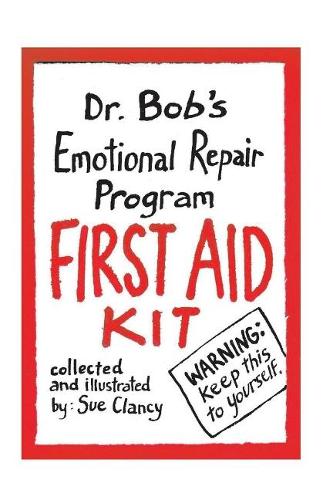
Dr. Bob's Emotional Repair Program First Aid Kit: Warning: keep this to yourself!
(Paperback)
Publishing Details
Dr. Bob's Emotional Repair Program First Aid Kit: Warning: keep this to yourself!
By (Author) sue clancy
By (author) bob hoke
BookBaby
BookBaby
7th February 2020
United States
Classifications
General
Non Fiction
158.1
Physical Properties
Paperback
56
Width 139mm, Height 215mm, Spine 2mm
108g
Description
We all feel bad from time to time but how do we deal with these feelings Do the ways we cope with emotional issues hurt us further or do they help us Perhaps we need a new story. Over the years Dr. Bob Hoke, a psychiatrist, has created a series of therapeutic discussions devoted to "Emotional Repair". Dr. Bob, in his "Emotional Repair Program" uses fictional stories to help us learn to repair our own emotions and deal with the non-fictional world. During animated conversation Dr. Bob shared his stories and their therapeutic context within the "Emotional Repair Program" with Sue Clancy, an artist, who wrote notes and illustrated the stories as Dr. Bob talked. Sue, with Dr. Bob's encouragement, collected her notes and cartoon/graphic novel style illustrations into this book. Dr. Bob's Emotional Repair Program is based on the following assumptions: -People DO have the resources and strengths to resolve their complaints and create emotional growth. -Emotional repair does NOT require long-term therapy.-Practical results can be achieved in a short time.This First Aid Kit focuses on the immediately needed skills to quickly repair emotions and develop the inner resources to resolve emotional problems. The First Aid Kit is a series of fictional stories and non-fiction cognitive behavior practices which come with a strong warning: Keep this First Aid Kit to yourself! Resist the impulse to teach the practices in this book to anyone else! You live these practices first let other people learn from your example! As the master said "Don't try to teach a pig to sing, it wastes your time and irritates the pig."
Author Bio
Sue Clancy creates visual stories about being human and having a brain in a variety of formats: fine art, illustrations, cartoons and artist books. She attempts to apply good-mental-health techniques to her creative life.
Her visual stories (words and images) have been published in Oregon Coast Magazine, Art Focus, Art Calendar Magazine, The Oklahoma Observer, The Oklahoma Gazette, Barrelhouse Magazine, The Raven Chronicles, The Tishman Review and many other publications. Her work has also appeared in books by publishers such as; Village Books Press, Lark Books, Ten Speed Press, Microcosm Publishing, Allyn & Bacon, The Buckmaster Institute in Canada as well as on products created by the Syracuse Cultural Workers and many others.
Her fine art can be seen at Caplan Art Designs in Portland Oregon (www.caplanartdesigns.com) or at Joseph Gierek Fine Art in Tulsa Oklahoma (www.gierek.com). Clancy's artwork has been purchased for the collections of the UCLA Fine Arts library and the Bainbridge Island Art Museum - her art resides in many public and private collections.
She lives and loves well with her longtime partner Judy and their pets in the Pacific Northwest. More about her work can be seen here: www.sueclancy.com
Dr. Bob Hoke (deceased) grew up in Oklahoma City and graduated from the University of Oklahoma School of Medicine in 1958. He had wanted to be a psychiatrist but during his internship at the Naval Hospital, Chelsea, Massachusetts he became interested in a Navy career and Submarine Medicine. After training in Submarine Medicine, deep sea diving, radiation biology and nuclear power technology he spent the next three years on sea duty with nuclear powered submarines. This was followed by residency training in Occupational Medicine at UCLA and the M.P.H. degree. During the next six years he taught Undersea Medicine and headed the Environmental Stress Research Division at the Naval Medical Research Institute in Bethesda before finally saying "I still want to become a psychiatrist."
So, at age forty-one, as a Captain in the Navy, he entered psychiatry training at Oakland Naval Regional Medical Center. After completing training, he became Chief of Psychiatry at Long Beach Naval Regional Medical Center where he ran the in-patient unit and worked closely with the alcohol rehabilitation unit. His interest in preventive medicine led to the development of a series of lectures designed for sailors under stress. Captain Hoke retired after twenty-three years of active duty to become a fulltime faculty member at the University of Texas Medical School in Houston. As head of the Adult Psychiatry Unit at Hermann Hospital he continued to develop his self-management lectures for patients in both the adult unit and those in the alcohol rehabilitation unit. In 1984 Dr. Hoke went into private practice and retained his teaching appointment and his active interest in helping emotionally disturbed people help themselves. He met his wife, Penny, an RN in the mental health field, and they have collaborated for the past 28 years.
Over the years Dr. Hoke has created a series of therapeutic lectures and discussions devoted to "Emotional Repair". The Emotional Repair Program is based on the following assumptions: patients do have the resources and strengths to resolve their complaints and create emotional growth. Emotional repair does not require long-term therapy; practical results can be achieved in a short time. It is usually unnecessary to know a great deal about the origins of a problem before beginning to find the inner resources to resolve it. Instead of focusing on pathology the Emotional Repair Program focuses on the power to achieve emotional growth.
He is Board Certified in both Psychiatry and Occupational Medicine. He is currently in private practice in Norman, Oklahoma.
Dr. Hoke acknowledges that the practices in this book, now known as CBT (Cognitive Behavior Therapy) have a long ancestry; thanks to Epictetus, Marcus Aurelius, Albert Ellis, Aaron Beck and his own teachers Maxine Maultsby and Bill O'Hanlon.
